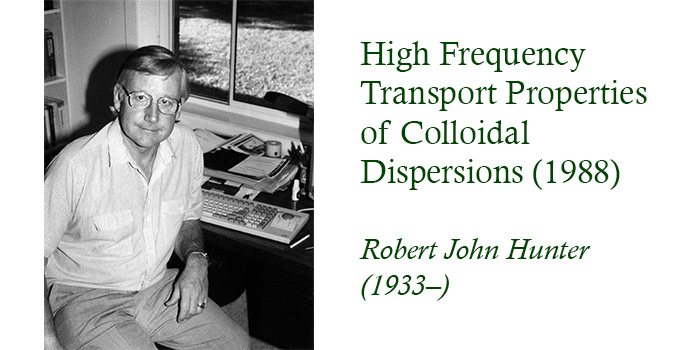26: High Frequency Transport Properties of Colloidal Dispersions (1988)
Abstract
Liversidge Research Lecture, delivered before the Royal Society of New South Wales, 27th July, 1988. Reproduced by permission of the Royal Society of New South Wales from J. Proc. Roy. Soc. N.S.W., 1988, 121, 165-178.
"Colloidal dspersions occur in a wide range of scientific and technological situations and their proper characterisation is an important area of scientific activity. Almost all colloidal systems are composed of particles which carry a net electrical charge on their surfaces, unless special precautions are taken to remove that charge. Indeed, apart from particle size and shape, electrical charge is probably the most important property determining the behaviour in almost all situations.
"Both the static (equilibrium) and the kinetic charge are normally determined and the two values used to develop a picture of the charge distribution in the region around each particle. That information can then be used to calculate the electrostatic interactions between the particles and hence, to estimate many important aspects of behaviour.
"This paper describes some important new techniques for estimating the magnitude of the charge and its distribution in the neighbourhood of the surface. Important new insights are gained from the study of the conductance and dielectric behaviour at high frequencies (around 1 MHz) and by the study of the interaction of ultrasonic waves and electrical fields at the same frequencies."
References
Bikerman, J.J., 1935. Kolloid Zeitschrift, 72, 100.
Booth, F., 1950. Proceedings of the Royal Society (London) , A 203, 514.
Booth, F. and Enderby, J.A., 1952. Proceedings of the Physical Society, 208 A , 321.
Debye, P., 1933. Journal of Chemical Physics, 1, 13.
Hermans, J., 1938. Philosophical Magazine, 25, 426, 674.
Midmore, B.R. and Hunter, R.J., 1987. Journal of Colloid and Interface Science, 122, 521-9.
O'Brien, R.W., 1986. Journal of Colloid and Interface Science, 110, 477.
O'Brien, R.W., 1988. Journal of Fluid Mechanics, 190, 71-86.
O'Brien, R.W. and White, L.R., 1978. Journal of the Chemical Society (London) Faraday Trans., 2, 74, 1607.
Overbeek, J.Th.G., 1942. Kolloid Beihefte, 54, 287.
Yeager, E. et al., 1953. Journal of the Acoustic Society of America, 25, 443.

